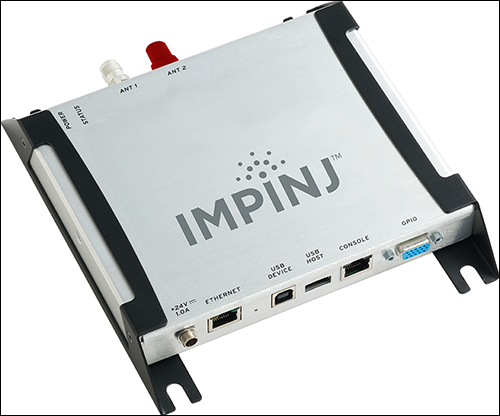Impinj has released a new fixed RAIN RFID reader with just a single port, designed for smaller, specific applications for which a lone antenna is a better fit for retailers, health-care companies and logistics providers. The offering, the company says, signals a growing need for a broader choice in deploying custom installations.
The Speedway R120 RAIN RFID reader is intended to compete with handheld readers in small installations or in very specific locations, at a price competitive with the handheld devices: $795.
The new reader is Impinj’s solution to the increasing flexibility required by its partners (systems integrators) and their customers, which are often smaller retailers, health-care facilities or logistics companies that need a single read point for a very specific purpose. The R120 comes with a hub unit to enable up to eight antennas if a user scales up its use case, according to John Frederiksen, Impinj’s senior director of product management.
Impinj already sells two other members of its Speedway reader family designed for a variety of use cases: the R220, with two ports, and the R420, with four ports. “Impinj’s reader components are used to build custom solutions,” Frederiksen says, and for that reason, the readers “are really designed for wide range of reading environments.”
The latest version addresses several use cases that are often managed via handheld readers. For instance, smaller retail locations sometimes use handheld readers at locations such as the point of sale (POS). With the R120, that can be accomplished hands-free. The reader, which is the same size as the other Speedway reader models, can be powered via a DC power connection or Power-over-Ethernet. It can read any EPC UHF RAIN RFID tags. Users can install the reader and begin capturing the tag ID numbers of product tags as customers bring them to the POS terminal.
Speedway R120s could be used in single fitting rooms, or at a collection area where customers deposit garments that they have already tried on.
A growing number of products are arriving at stores with RFID tags attached. Therefore, Frederiksen explains, some retailers are interested in installing a one-port reader at locations such as receiving doors, where incoming garments or other merchandise are received. This, he says, automates a process that previously required visual inspection of items, spreadsheets, bar-code scanners or a handheld reader.
One benefit that fixed readers offer over handhelds, Frederiksen notes, is not just reducing the amount of labor involved in reading the tags, but gaining real-time data. “A key advantage of the R120 over handheld readers is the access it gives stores to real time data.” Stores that employ RFID typically upload handheld read data once or twice daily, whereas the Speedway R120 can forward data directly to the store’s own software as the tags are being read.
The health-care industry has also expressed an interest in the technology, Frederiksen says. “One use case is in the operating rooms,” he states, where hospitals or clinics can track the flow of supplies or implants used during surgery. By installing a one-port reader within range of a garbage container, a facility’s health-care management team can view which products were used during a specific procedure (based on the unique ID number on a tagged package being discarded), or confirm that a disposable tool or supply was disposed of after a single use. In this way, hospitals can ensure that no such item is reused on another patient.
In addition, health-care organizations have expressed an interest in utilizing the readers for specimen tracking—to identify when liquid blood or tissues samples are received, processed or transported, for instance.
Another market that is interested in the Speedway R120, Frederiksen says, is transportation and logistics, for which handheld readers are commonly used, especially at smaller distribution centers or warehouses. A fixed Speedway R120 can capture the movements of goods as they pass through a portal without requiring the manual efforts of a handheld reader, he adds, and with real-time data collection.
While other companies make single-port readers, Frederiksen says, the Impinj product, as part of the Speedway family, delivers the same performance and reliability and comes with the firm’s maturity in the market as a provider of RFID readers, chips and solutions. Moreover, the device comes with a tool set that includes a software development kit (SDK), as well as Speedway Connect, which enables users to set up basic reader configurations via its simplified graphical user interface (GUI).
With this latest offering, Frederiksen says, “I think we’re seeing a maturity of RFID adoption, with an increase in willingness to use fixed infrastructure” to capture RFID tag reads. “I think users are seeing a value in the data and having continuous access to those data points.”
The Speedway R120 reader can interrogate up to 200 tags per second. It measures 7.5 inches by 6.9 inches by 1.2 inches, as do the R220 and R420 models. An additional port pack on the R120 allows users to add antennas and read zones as needed if their use cases grow. Impinj has begun shipping the product with its commercial release this month.



